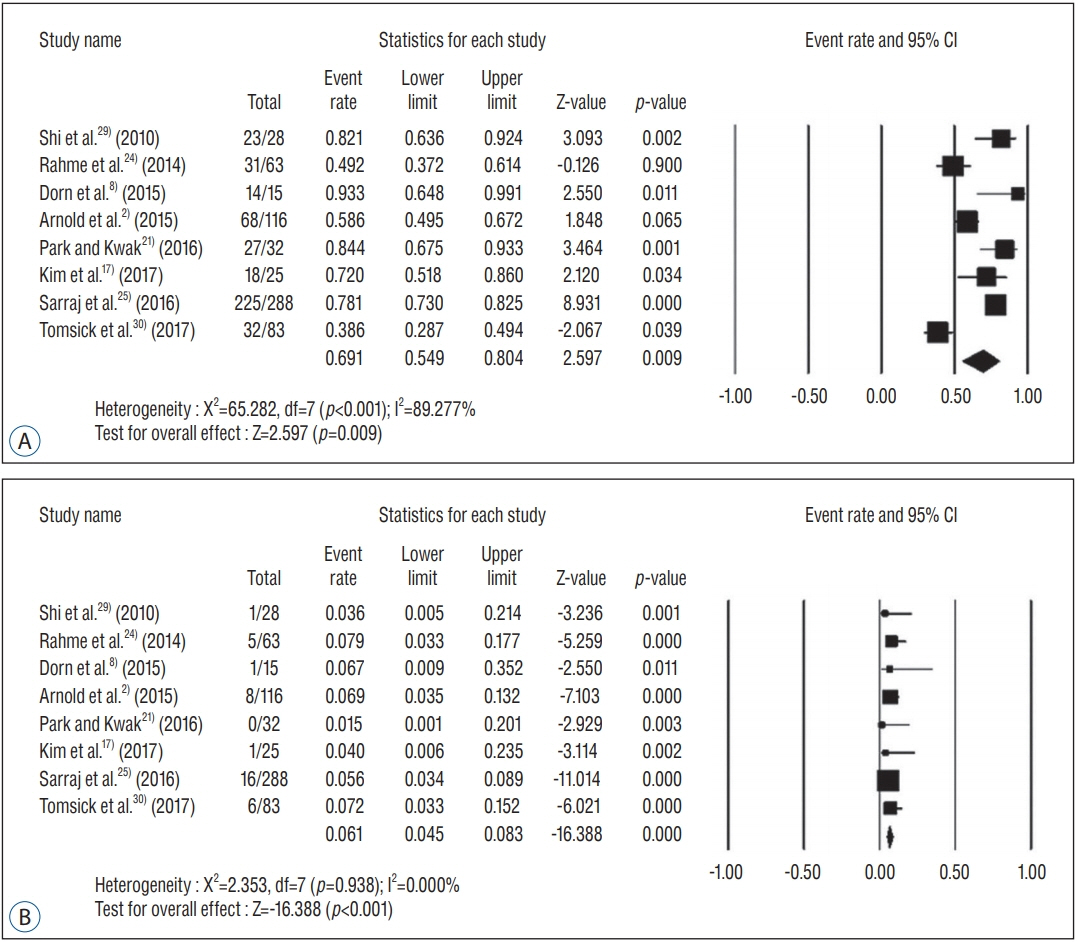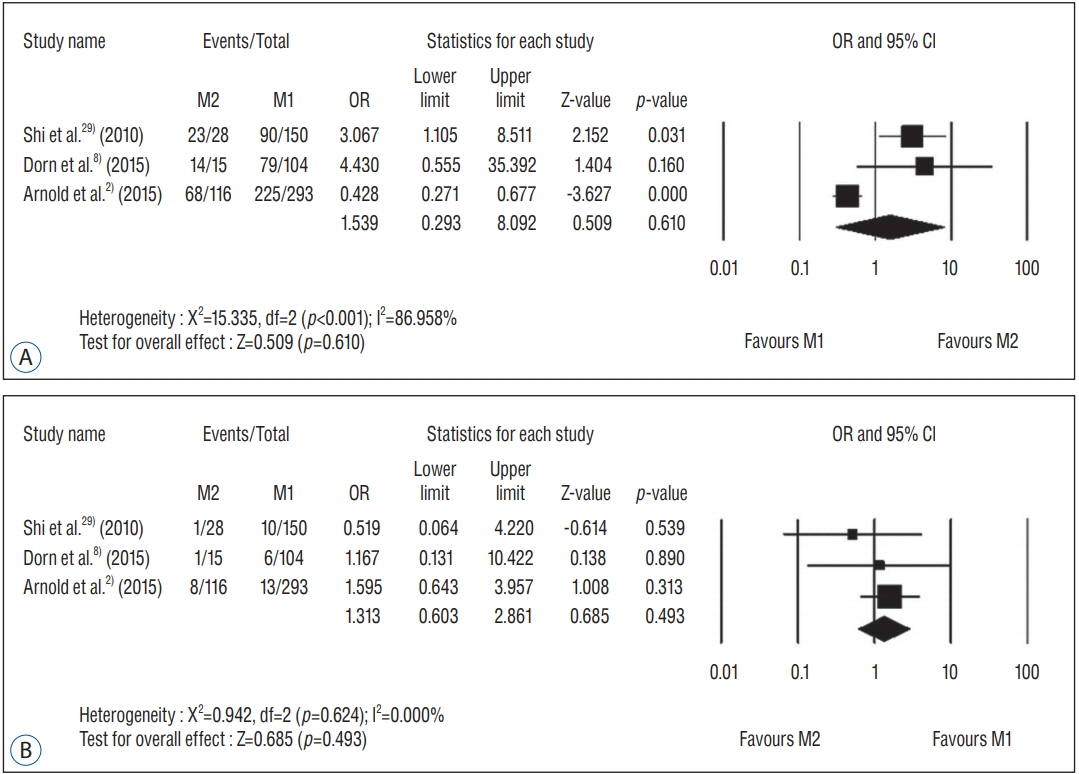J Korean Neurosurg Soc.
2019 Mar;62(2):193-200. 10.3340/jkns.2017.0299.
Meta-Analysis of Endovascular Treatment for Acute M2 Occlusion
- Affiliations
-
- 1Department of Neurology, Hallym University College of Medicine, Chuncheon, Korea.
- 2Department of Emergency Medicine, Seoul Emergency Operations Center, Seoul, Korea.
- 3Institute of New Frontier Stroke Research, Hallym University College of Medicine, Chuncheon, Korea. jjs6553@daum.net
- 4Genetic and Research Incorporation, Chuncheon, Korea.
- 5Department of Neurosurgery, Hallym University College of Medicine, Chuncheon, Korea.
- KMID: 2441563
- DOI: http://doi.org/10.3340/jkns.2017.0299
Abstract
OBJECTIVE
Endovascular treatment (EVT) outcomes for acute M2 segment of middle cerebral artery occlusion remains unclear because most results are obtained from patients with large artery occlusion in the anterior circulation. The objective of this study was to assess procedural outcomes for acute M2 occlusion and compare outcomes according to thrombus location (M1 vs. M2).
METHODS
A systematic review was performed for online literature published from January 2004 to December 2016. Primary outcome was successful recanalization rate and symptomatic intracranial hemorrhage (S-ICH) after the procedure. A fixed effect model was used if heterogeneity was less than 50%.
RESULTS
Eight articles were included. EVT showed successful recanalization rate of 69.1% (95% confidence interval [CI], 54.9-80.4%) and S-ICH rate of 6.1% (95% CI, 4.5-8.3%). The rates of good clinical outcome at 3 months and mortality were 59.4% (95% CI, 49.9-68.2%) and 14.9% (95% CI, 11.4-19.3%), respectively. According to thrombus location (M1 vs. M2), successful recanalization (odds ratio [OR], 1.539; 95% CI, 0.293-8.092; p=0.610) and S-ICH (OR, 1.313; 95% CI, 0.603-2.861; p=0.493) did not differ significantly. Good clinical outcome was more evident in M2 occlusion after EVT than that in M1 occlusion (OR, 1.639; 95% CI, 1.135-2.368; p=0.008). However, mortality did not differ significantly according to thrombus location (OR, 0.788; 95% CI, 0.486-1.276; p=0.332).
CONCLUSION
EVT seems to be technically feasible for acute M2 occlusion. Direct comparative studies between EVT and medical treatment are needed further to find specific beneficiary group after EVT in patient with M2 occlusion.
Keyword
MeSH Terms
Figure
Reference
-
References
1. Almekhlafi MA, Menon BK, Freiheit EA, Demchuk AM, Goyal M. A meta-analysis of observational intra-arterial stroke therapy studies using the Merci device, Penumbra system, and retrievable stents. AJNR Am J Neuroradiol. 34:140–145. 2013.
Article2. Arnold M, Slezak A, El-Koussy M, Lüdi R, Findling O, Mono ML, et al. Occlusion location of middle cerebral artery stroke and outcome after endovascular treatment. Eur Neurol. 74:315–321. 2015.
Article3. Badhiwala JH, Nassiri F, Alhazzani W, Selim MH, Farrokhyar F, Spears J, et al. Endovascular thrombectomy for acute ischemic stroke: a metaanalysis. JAMA. 314:1832–1843. 2015.
Article4. Begg CB, Mazumdar M. Operating characteristics of a rank correlation test for publication bias. Biometrics. 50:1088–1101. 1994.
Article5. Broussalis E, Trinka E, Hitzl W, Wallner A, Chroust V, Killer-Oberpfalzer M. Comparison of stent-retriever devices versus the Merci retriever for endovascular treatment of acute stroke. AJNR Am J Neuroradiol. 34:366–372. 2013.
Article6. Bush CK, Kurimella D, Cross LJ, Conner KR, Martin-Schild S, He J, et al. Endovascular treatment with stent-retriever devices for acute ischemic stroke: a meta-analysis of randomized controlled trials. PLoS One. 11:e0147287. 2016.
Article7. Coutinho JM, Liebeskind DS, Slater LA, Nogueira RG, Baxter BW, Levy EI, et al. Mechanical thrombectomy for isolated M2 occlusions: a post hoc analysis of the STAR, SWIFT, and SWIFT PRIME studies. AJNR Am J Neuroradiol. 37:667–672. 2016.
Article8. Dorn F, Lockau H, Stetefeld H, Kabbasch C, Kraus B, Dohmen C, et al. Mechanical thrombectomy of M2-occlusion. J Stroke Cerebrovasc Dis. 24:1465–1470. 2015.
Article9. Goyal M, Menon BK, van Zwam WH, Dippel DW, Mitchell PJ, Demchuk AM, et al. Endovascular thrombectomy after large-vessel ischaemic stroke: a meta-analysis of individual patient data from five randomised trials. Lancet. 387:1723–1731. 2016.
Article10. Grech R, Pullicino R, Thornton J, Downer J. An efficacy and safety comparison between different stentriever designs in acute ischaemic stroke: a systematic review and meta-analysis. Clin Radiol. 71:48–57. 2016.
Article11. Hentschel KA, Daou B, Chalouhi N, Starke RM, Clark S, Gandhe A, et al. Comparison of non-stent retriever and stent retriever mechanical thrombectomy devices for the endovascular treatment of acute ischemic stroke. J Neurosurg. 126:1123–1130. 2017.
Article12. Jankowitz B, Grandhi R, Horev A, Aghaebrahim A, Jadhav A, Linares G, et al. Primary manual aspiration thrombectomy (MAT) for acute ischemic stroke: safety, feasibility and outcomes in 112 consecutive patients. J Neurointerv Surg. 7:27–31. 2015.
Article13. Jeon JP, Kim JE. A recent update of clinical and research topics concerning adult moyamoya disease. J Korean Neurosurg Soc. 59:537–543. 2016.
Article14. Jeon JP, Kim JE, Cho WS, Bang JS, Son YJ, Oh CW. Meta-analysis of the surgical outcomes of symptomatic moyamoya disease in adults. J Neurosurg. 128:793–799. 2018.
Article15. Jeon JP, Kim SE, Kim CH. Endovascular treatment of acute ischemic stroke in octogenarians: a meta-analysis of observational studies. Clin Neurol Neurosurg. 161:70–77. 2017.
Article16. Jeon JP, Kim SE, Kim CH. Primary suction thrombectomy for acute ischemic stroke: a meta-analysis of the current literature. Clin Neurol Neurosurg. 163:46–52. 2017.
Article17. Kim YW, Son S, Kang DH, Hwang YH, Kim YS. Endovascular thrombectomy for M2 occlusions: comparison between forced arterial suction thrombectomy and stent retriever thrombectomy. J Neurointerv Surg. 9:626–630. 2017.
Article18. Lapergue B, Blanc R, Guedin P, Decroix JP, Labreuche J, Preda C, et al. A direct aspiration, first pass technique (ADAPT) versus stent retrievers for acute stroke therapy: an observational comparative study. AJNR Am J Neuroradiol. 37:1860–1865. 2016.
Article19. Liberati A, Altman DG, Tetzlaff J, Mulrow C, Gøtzsche PC, Ioannidis JP, et al. The PRISMA statement for reporting systematic reviews and meta-analyses of studies that evaluate healthcare interventions: explanation and elaboration. BMJ. 339:b2700. 2009.
Article20. Lo CK, Mertz D, Loeb M. Newcastle-Ottawa Scale: comparing reviewers’ to authors’ assessments. BMC Med Res Methodol. 14:45. 2014.
Article21. Park JS, Kwak HS. Manual aspiration thrombectomy using penumbra catheter in patients with acute M2 occlusion : a single-center analysis. J Korean Neurosurg Soc. 59:352–356. 2016.
Article22. Pereira VM, Gralla J, Davalos A, Bonafé A, Castaño C, Chapot R, et al. Prospective, multicenter, single-arm study of mechanical thrombectomy using Solitaire Flow Restoration in acute ischemic stroke. Stroke. 44:2802–2807. 2013.
Article23. Qian C, Yu X, Li J, Chen J, Wang L, Chen G. The efficacy of surgical treatment for the secondary prevention of stroke in symptomatic moyamoya disease: a meta-analysis. Medicine (Baltimore). 94:e2218. 2015.24. Rahme R, Yeatts SD, Abruzzo TA, Jimenez L, Fan L, Tomsick TA, et al. Early reperfusion and clinical outcomes in patients with M2 occlusion: pooled analysis of the PROACT II, IMS, and IMS II studies. J Neurosurg. 121:1354–1358. 2014.
Article25. Sarraj A, Sangha N, Hussain MS, Wisco D, Vora N, Elijovich L, et al. Endovascular therapy for acute ischemic stroke with occlusion of the middle cerebral artery M2 segment. JAMA Neurol. 73:1291–1296. 2016.
Article26. Saver JL, Goyal M, Bonafe A, Diener HC, Levy EI, Pereira VM, et al. Solitaire™ with the Intention for Thrombectomy as Primary Endovascular Treatment for Acute Ischemic Stroke (SWIFT PRIME) trial: protocol for a randomized, controlled, multicenter study comparing the Solitaire revascularization device with IV tPA with IV tPA alone in acute ischemic stroke. Int J Stroke. 10:439–448. 2015.
Article27. Saver JL, Jahan R, Levy EI, Jovin TG, Baxter B, Nogueira RG, et al. Solitaire flow restoration device versus the Merci Retriever in patients with acute ischaemic stroke (SWIFT): a randomised, parallel-group, noninferiority trial. Lancet. 380:1241–1249. 2012.
Article28. Sheth SA, Yoo B, Saver JL, Starkman S, Ali LK, Kim D, et al. M2 occlusions as targets for endovascular therapy: comprehensive analysis of diffusion/perfusion MRI, angiography, and clinical outcomes. J Neurointerv Surg. 7:478–483. 2015.
Article29. Shi ZS, Loh Y, Walker G, Duckwiler GR, Multi-MERCI Investigators. Clinical outcomes in middle cerebral artery trunk occlusions versus secondary division occlusions after mechanical thrombectomy: pooled analysis of the mechanical embolus removal in cerebral ischemia (MERCI) and multi MERCI trials. Stroke. 41:953–960. 2010.
Article30. Tomsick TA, Carrozzella J, Foster L, Hill MD, von Kummer R, Goyal M, et al. Endovascular therapy of M2 occlusion in IMS III: role of M2 segment definition and location on clinical and revascularization outcomes. AJNR Am J Neuroradiol. 38:84–89. 2017.
Article31. Turk AS, Spiotta A, Frei D, Mocco J, Baxter B, Fiorella D, et al. Initial clinical experience with the ADAPT technique: a direct aspiration first pass technique for stroke thrombectomy. J Neurointerv Surg. 6:231–237. 2014.
Article
- Full Text Links
- Actions
-
Cited
- CITED
-
- Close
- Share
- Similar articles
-
- Mechanical thrombectomy for acute ischemic stroke with occlusion of the M2 segment of the middle cerebral artery: A literature review
- Causes and Solutions of Endovascular Treatment Failure
- Emergency Microsurgical Embolectomy for the Treatment of Acute Intracranial Artery Occlusion: Report of Two Cases
- A novel hybrid technique to treat flush mesenteric arterial occlusion in acute-on-chronic mesenteric ischemia
- Complete Revascularization of Juxtarenal Aortic Occlusion by Endovascular Treatment and Adjunctive Anticoagulation




